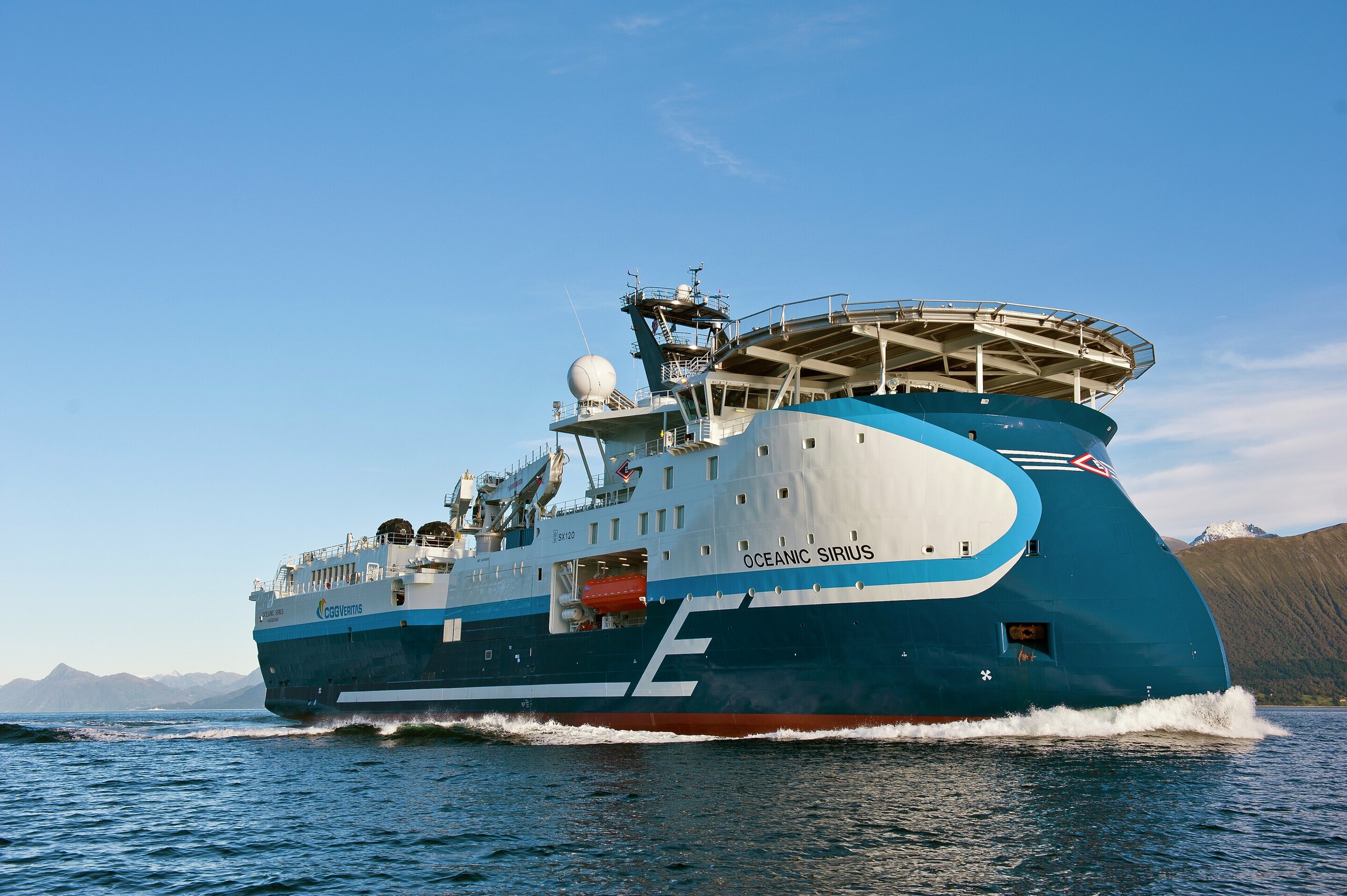
Oceanic Sirius
Seismic research vessel with a towing force of 140t during seismic operations. Ideally suited to acquisition of large 3D, 4D or high-resolution projects, utilizing a streamer configuration of up 16 streamers separated by 100 m or more. The 20 streamer winches are each capable of spooling 9 kilometres of streamers.
Primary specifications as built
Additional Data
Ship history
Ulstein Verft delivered the vessel on 3 October 2011 to Oceanic Seismic Vessels - a company owned by Eidesvik Offshore and the seismic operator CGG Veritas. She is a sister vessel to Oceanic Vega, delivered in 2010.
On the occasion of the sister vessel's naming, Jan Fredrik Meling, CEO at Eidesvik Offshore, stated: "She meets strict environmental standards. Equipped with state-of-the-art technology, the ship reduces harmful atmospheric emissions and prevents oil discharge through the double hull construction. We are very satisfied with the X-BOW® vessel Viking Poseidon previously delivered by Ulstein. The ship operates smoothly with minimal vibrations and movements. This grants optimal vessel comfort, which is very important for the working conditions of our seafarers."
Carrying an ICE-C classification, the Oceanic Sirius can operate in cold waters. The vessel is designed to stay permanently at sea, with five-year docking intervals, and complies with the redundant propulsion notation from DNV. There are enough engines and generator sets to conduct maintenance at sea, and refuelling is carried out by dedicated support vessels. The vessel has straight shaft lines to the two CP propellers in a nozzle, each driven by two frequency converter-driven electric motors. This allows smooth speed control of around five knots during seismic acquisition. Two work boats are used for the maintenance of in-water equipment.
Working environment
Oceanic Sirius complies with the Clean Design demands from DNV and the SPS requirements for up to 60 persons. There are 52 single cabins and only nine double cabins. The mess room, galley and four dayrooms have large windows facing the sea for the crew's comfort. The vessel is equipped with a helideck to facilitate an efficient crew change. The X-BOW® results in lower added resistance and smoother bow immergence. This leads to reduced operational disturbances or involuntary speed reduction.
Instrument room
The instrument room is at the stern, with large windows facing the sea. It is placed directly over the seismic area and has a direct view of the streamer deck.
Equipment delivery
Ulstein Power & Control delivered much of the vessel's equipment, including switchboards, the ULSTEIN COM information and communication system, and the ULSTEIN IAS integrated automation system, which is equipped with integrated modules, including a power management system and modules for monitoring the helideck and the ballast water system.
The X-BOW is particularly suitable for the seismic industry
From an article in The Motorship magazine:
The owners consider Ulstein's X-BOW configuration to be particularly suitable for the demands of the seismic industry, offering reduced surging and turbulence. The bow design is said to result in lower added resistance and smoother bow immergence, leading to reduced operational disturbance and involuntary speed reduction. The hull design allows optimisation for seismic towing operations at 4.5/5.0 knots, leading to reduced noise and fuel consumption and lower CO2 emissions. The propulsion and manoeuvring system is also designed for this type of work, while allowing the ships to travel quickly and economically to and from the survey areas. Seismic surveys tend to be long jobs, and Oceanic Sirius is designed with the capability to remain at sea for extended periods, with the capability of being refuelled at sea, reducing the need to return to port. Her sister ship, the Oceanic Vega, is said to have spent over one year continuously at sea. For such operating patterns, comprehensive storage facilities must be provided onboard. Additionally, high-calibre seismic scientists are in short supply, so provision of a comfortable working environment and off-duty facilities are another important consideration. Our view of the ship suggested a standard of fitting out and provision of equipment that was far closer to a cruise ship than an offshore working vessel.
June 2019: Oceanic Seismic Vessels AS was acquired by Shearwater Geoservices.
November 2024: Shearwater Geoservices was awarded a contract by India’s Oil & Natural Gas Corporation for a 3D seismic survey off India’s east coast, to be conducted by Oceanic Sirius over four months starting in early 2025.